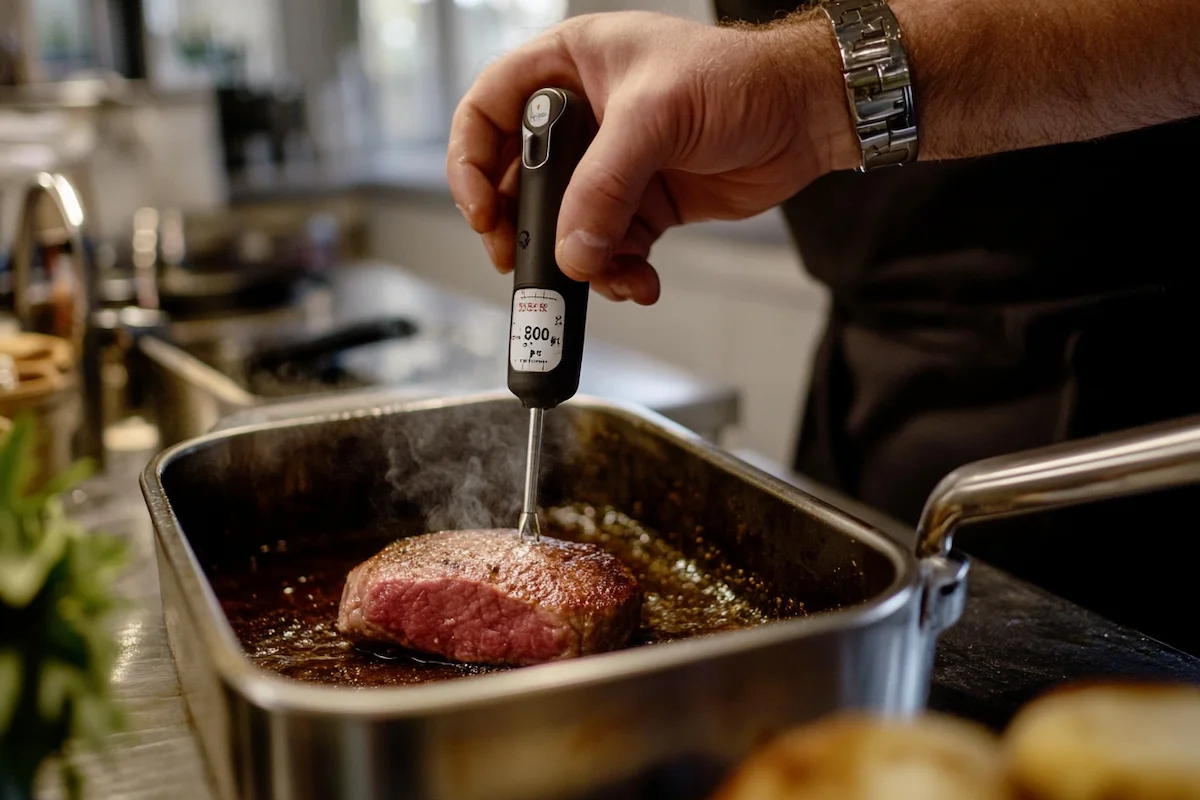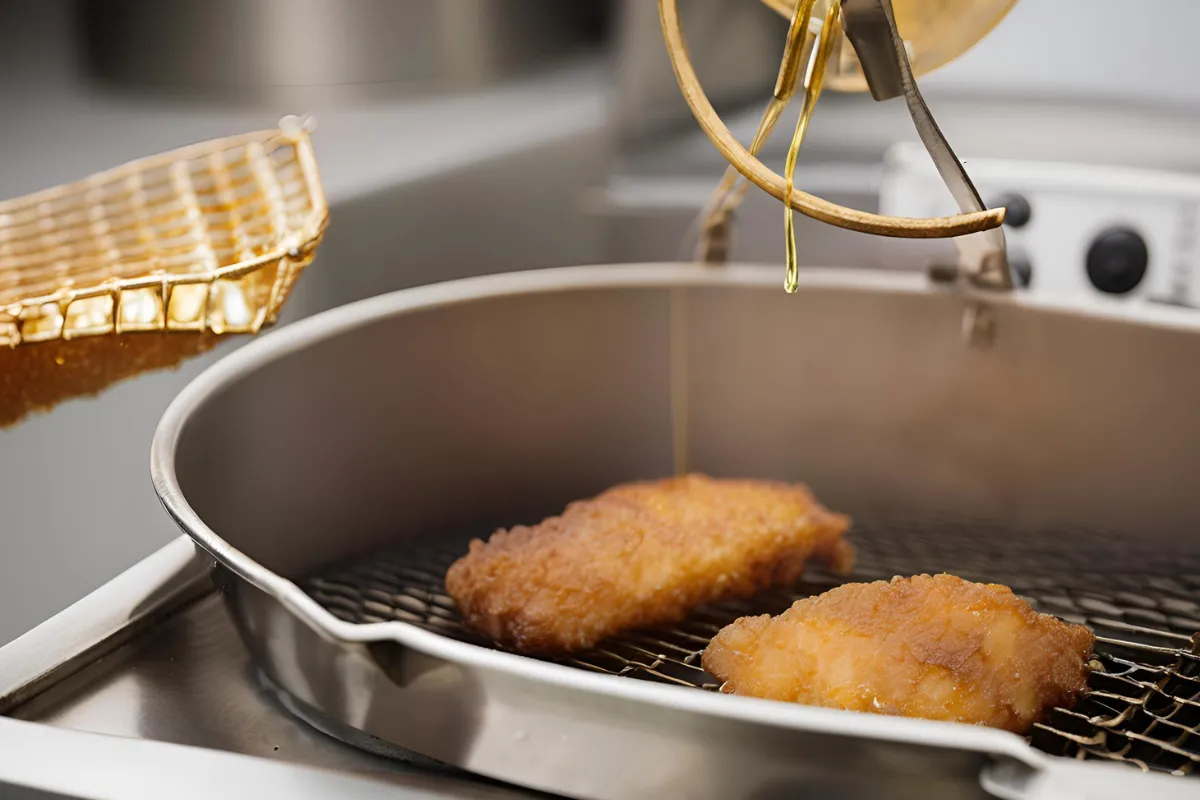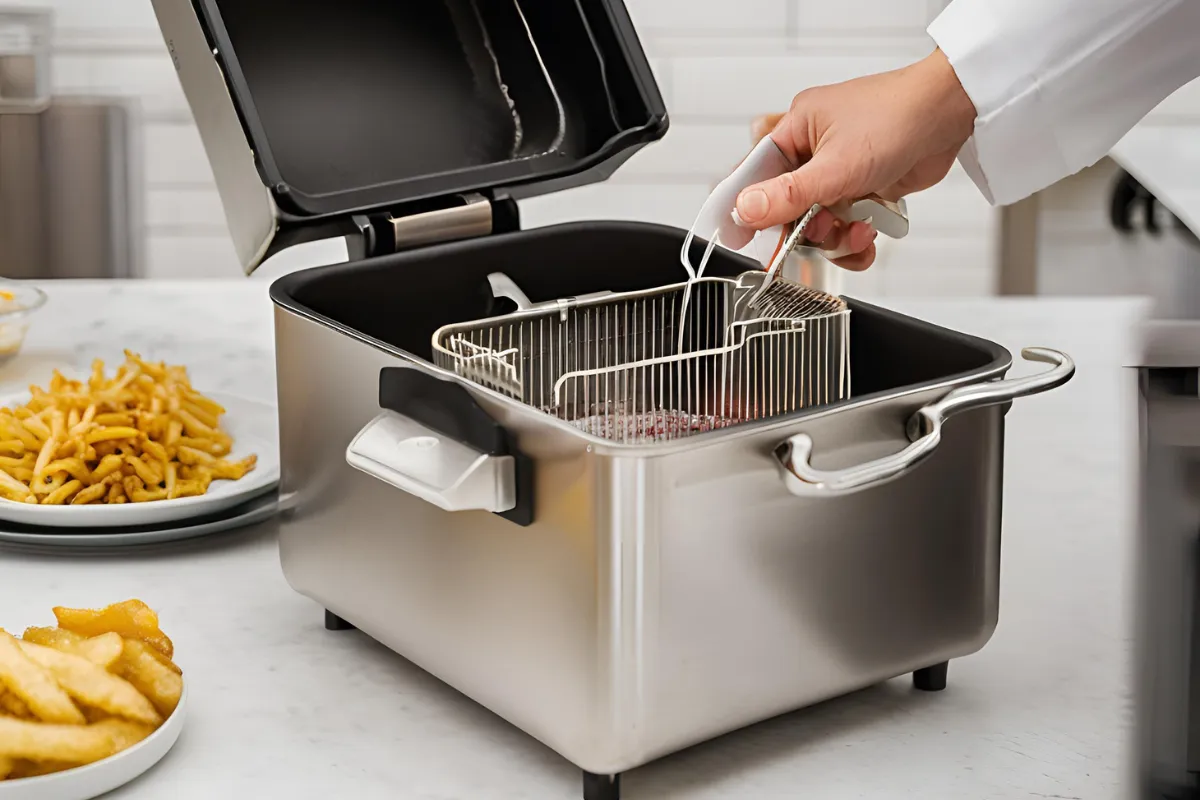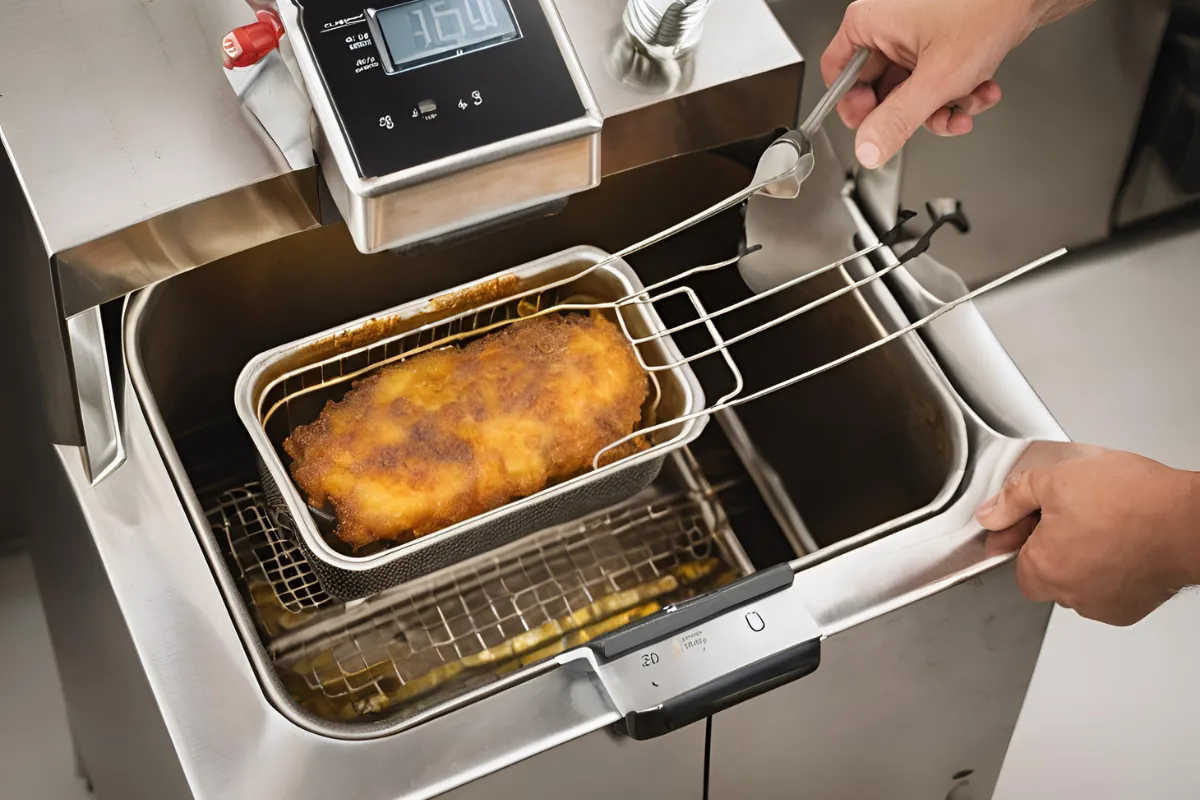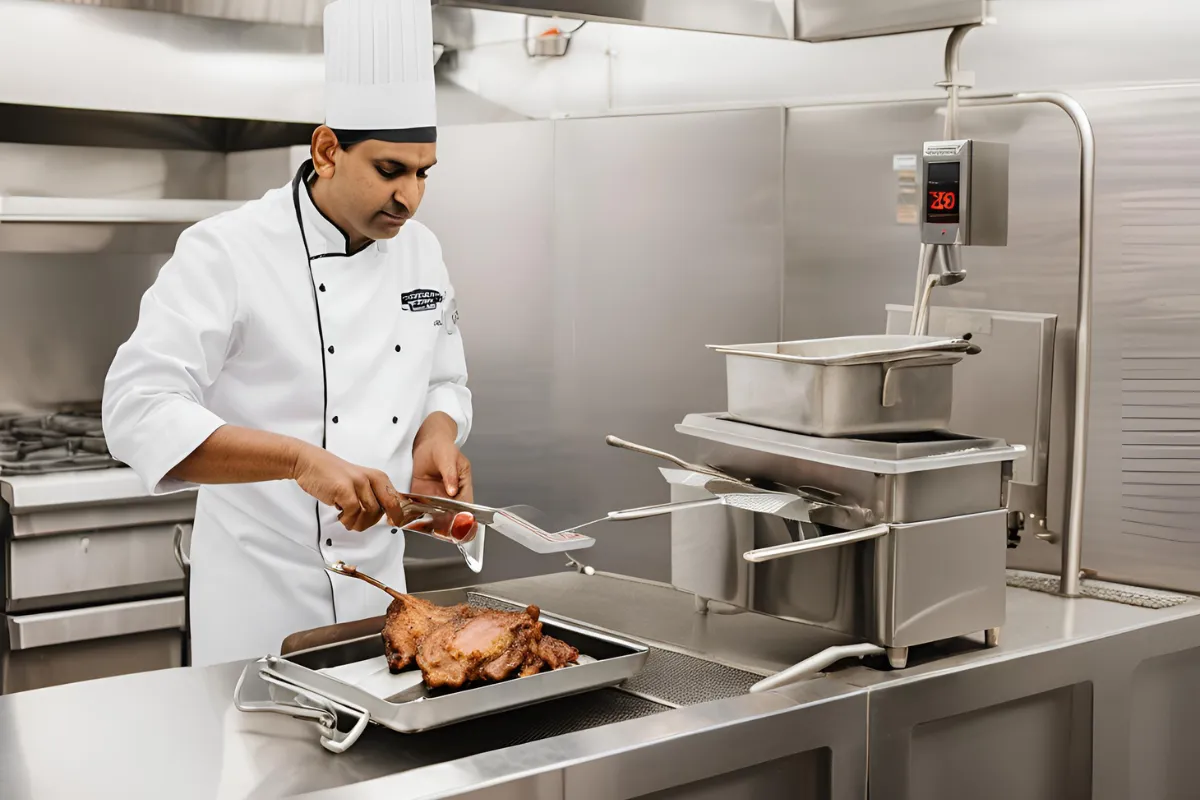Understanding Frying Temperatures
The Basics of Frying Filets
When cooking filets, the fryer temperature plays a crucial role in achieving the right texture and flavor. Frying at the wrong temperature can lead to greasy, soggy, or burnt filets. However, when the temperature is just right, you get a crispy exterior and tender, juicy inside. So, how do you achieve the perfect temperature?
The fryer temperature for cooking filets isn’t the same for all types. It depends on several factors, such as the type and thickness of the filet. Whether the filet is breaded or not also affects the temperature. For example, fish filets need lower temperatures than chicken filets, which require higher heat for a crispy crunch.
Frying involves immersing food in hot oil, usually between 300°F and 375°F. The oil’s temperature must be carefully managed to avoid overcooking the outer layer. At the same time, you need to ensure that the inside of the filet cooks thoroughly. 350°F is often the ideal temperature for most filets. It cooks quickly and evenly without burning the food.
Why Temperature Matters When Frying Filets
You might wonder why temperature matters so much when frying filets. The answer is in the science of heat transfer. When you drop a filet into hot oil, the exterior cooks immediately. If the oil is too cool, the outer layer absorbs too much oil, making the filets greasy. On the other hand, if the oil is too hot, the outside may burn before the inside cooks through.
The goal is to maintain a stable temperature. The oil should be hot enough to crisp the exterior quickly. It should also allow heat to penetrate the inside. This balance is essential, especially for delicate filets like fish, which require gentler frying than chicken.
If the temperature is too low, the filets become soggy. If it’s too high, the crust burns and the center remains raw. Maintaining the right frying temperature ensures perfectly cooked filets every time, whether you’re frying fish, chicken, or other proteins.
Optimal Fryer Temperature for Different Filet Types
Not all filets are created equal. For fish filets, the fryer temperature should be on the lower end of the scale, usually around 325°F to 350°F. Fish filets are delicate, and higher temperatures can cause them to cook too quickly on the outside while leaving the interior raw. The lower temperature allows for a more controlled cook, yielding a light, flaky texture.
For chicken filets, however, a slightly higher frying temperature is needed. Chicken filets (whether breaded or not) usually require a fryer temperature between 350°F and 375°F for the perfect balance of crispiness and juiciness. At this temperature, the chicken can cook through thoroughly without burning the outside. The higher heat helps seal in moisture, ensuring a tender interior with a crispy, golden exterior.
It’s important to remember that fryer settings can vary based on the type of oil you use as well. For example, some oils, like peanut oil or vegetable oil, have higher smoke points, meaning they can handle higher temperatures without breaking down. Choosing the right oil is just as important as setting the right temperature for frying filets.
The Right Fryer Temperature for Filets
General Guidelines for Frying Filets
When it comes to frying filets, achieving the right fryer temperature is half the battle. But how do you know what temperature is right for each type of filet? The industry-standard fryer temperatures can give you a solid foundation to start with.
For most types of filets, the sweet spot is typically between 325°F to 375°F (165°C to 190°C), depending on the protein and thickness of the filet. Culinary professionals commonly recommend this range because it cooks the food quickly, creating a crispy crust without overcooking the inside.
However, the exact fryer setting can vary based on what you’re cooking. For example, delicate fish filets generally need lower temperatures around 325°F to 350°F, as they can easily become dry and overcooked at higher temperatures. On the other hand, chicken or meat filets have denser flesh and can fry at temperatures up to 375°F, allowing the crust to develop while keeping the meat moist inside.
Why 350°F (175°C) is the Go-To Temperature for Most Filets
One temperature that works well for frying various filets is 350°F (175°C). This temperature strikes a perfect balance between speed and crispiness.
At 350°F, the oil is hot enough to cook the filets quickly. It ensures a crispy exterior while keeping the interior moist. This temperature works wonders for many fish and chicken filets. It’s not too high, which could burn the coating or overcook the food. It’s also not too low, which can lead to greasy filets. So, 350°F provides the ideal balance for a golden-brown, crispy outside and a tender, juicy inside.
Most fryers, whether electric or gas, maintain a steady 350°F. This makes it an easy and reliable setting for consistent results. If in doubt, set your fryer to 350°F. It ensures crispy, perfectly cooked filets, whether you fry fish, chicken, or other proteins.
How Long Should Filets Be Fried at This Temperature?
Once you set the fryer temperature, the next important factor is the frying time. The ideal frying time depends on several factors. These include the type, thickness, and whether the filet is battered or breaded. For most filets, the general rule is to fry them for about 4 to 6 minutes at 350°F.
For fish filets, thinner pieces need only 3 to 4 minutes of frying. Thicker fish filets may need up to 6 minutes. The best way to check if your fish is done is to gently flake it with a fork. If it flakes easily, it’s cooked through.
For chicken filets or other meats, thicker pieces may need 6 to 8 minutes depending on size. As with fish, always check the internal temperature. For chicken, the internal temperature should reach 165°F (74°C) before removing it from the fryer.
These guidelines are helpful, but timing is key. Over-frying or under-frying filets will affect both texture and flavor.
Effects of Over-Frying and Under-Frying
It’s easy to think that frying something for just a bit longer will improve the texture, but in reality, over-frying can be just as damaging as under-frying.
Over-frying leads to a dry, tough, and sometimes burnt exterior, and more often than not, the filet will be overcooked on the inside as well. Fish, in particular, is delicate and can dry out quickly if left in the oil for too long. Chicken can suffer from the same fate, with the coating turning hard and unappetizing.
On the other hand, under-frying can result in soggy, greasy filets that are not only unpleasant to eat but also unsafe. When the oil temperature is too low, the batter or breading soaks up too much oil, leaving the filet greasy. For thicker filets, under-frying could also result in raw or undercooked meat in the middle, which is a health risk. It’s crucial to keep an eye on both the fryer temperature and cooking time to avoid these issues.
Adjusting Fryer Temperature for Thickness and Coating of Filets
Now that you know the standard frying times and temperatures, you should also be aware that there are exceptions, particularly when it comes to the thickness of the filets and whether they are battered or breaded.
Thicker filets, such as a large chicken breast or a thick-cut fish filet, will require a slightly lower temperature or longer frying time. If you’re frying thick filets at 350°F, the outside may cook too quickly while the inside remains raw. In such cases, lowering the temperature slightly to 325°F or 330°F and increasing the cooking time by a minute or two allows for a more even cook.
If you’re frying breaded or battered filets, you may need to slightly adjust the temperature as well. Breaded filets, especially those with a thick coating, can sometimes require a bit more heat to ensure the coating becomes golden and crispy. If your fryer temperature is too low, the coating may not crisp up properly, leaving you with a soggy exterior. However, you don’t want the oil to be too hot, as this can cause the coating to burn before the meat inside is cooked.
For breaded fish or chicken filets, 325°F to 350°F is typically ideal. If you notice the coating is browning too quickly, reduce the temperature slightly to ensure the inside cooks through without the breading becoming overly dark.
Advanced Frying Techniques for Filets
Using a Thermometer to Monitor Fryer Temperature
When it comes to frying filets, a thermometer is your best friend. Without it, you’re essentially guessing the heat of the oil, which can lead to inconsistent results. Whether you’re frying fish, chicken, or another type of filet, having an accurate reading of the fryer temperature is crucial for achieving the perfect crispy texture and avoiding undercooked or burnt food.
A thermometer ensures that the oil stays within the optimal temperature range, usually between 325°F and 375°F, depending on the type of filet you’re cooking. Without this tool, it’s easy to let the temperature fluctuate, which can affect the quality of your food. The risk of overheating the oil or allowing it to cool too much is significant, especially when frying delicate items like fish filets.
Why is a thermometer essential? In short, it provides precise control. If the oil is too hot, your filets will cook too quickly, potentially burning the outside while leaving the inside raw. Conversely, if it’s too cold, the oil will soak into the filets, making them soggy and greasy. By using a thermometer, you can ensure that your fryer temperature remains stable, and that your filets cook evenly and consistently.
Types of Thermometers to Use for Frying Filets
Not all thermometers are suitable for frying. For deep-frying filets, you need a thermometer designed specifically for high temperatures. The most common options include:
- Candy or Deep Fry Thermometer – These are ideal for monitoring high heat, and they typically clip to the side of your fryer. They can measure temperatures up to 400°F (200°C), making them perfect for deep-frying filets.
- Digital Instant-Read Thermometers – These are handheld devices that quickly provide an accurate temperature reading. They can be used for both frying oil and checking the internal temperature of filets themselves. Keep in mind that you should be cautious with these around hot oil, as they can’t be left in the oil while frying.
- Oil Thermometers – These are specialized thermometers designed to withstand hot oil, offering a more precise reading while remaining in the fryer. They allow you to monitor the temperature constantly without needing to remove the fryer lid.
Using one of these thermometers will help you achieve the right fryer temperature for your filets and prevent any mishaps during cooking.
How to Maintain Consistent Fryer Temperature
Once you’ve set your fryer to the right temperature, maintaining consistency is key. Fluctuations in temperature can affect the cooking process and result in unevenly cooked filets.
Techniques to Prevent Temperature Fluctuations While Frying
Here are a few tips to ensure your fryer temperature stays stable throughout the frying process:
- Avoid overcrowding the fryer: Placing too many filets into the fryer at once can lower the oil temperature, leading to soggy filets. Fry in batches to maintain the heat.
- Stir the oil occasionally: Some fryers allow you to stir the oil gently. This helps maintain an even temperature and can prevent hot spots from forming in the fryer.
- Use a high-quality fryer: A well-built fryer with good insulation will keep the temperature more stable, even when frying multiple batches. Look for fryers with temperature controls that allow you to adjust the heat easily.
If you notice the oil temperature dipping below the optimal range, turn up the heat slightly. On the other hand, if the temperature goes above the ideal range, reduce it gradually to avoid burning your filets.
How to Manage Oil Temperature When Frying in Batches
If you’re frying large quantities of filets, it’s essential to manage the oil temperature between batches. The key to this is timing and careful monitoring. After each batch, the temperature of the oil will likely drop. Here’s what you can do:
- Let the oil heat up between batches: After frying the first batch, give the oil a few minutes to heat back up to the desired temperature (350°F for most filets) before adding the next batch.
- Keep an eye on the thermometer: Constantly check the temperature throughout the frying process. A few minutes of downtime between batches can make a big difference in maintaining consistent results.
Remember, maintaining the oil’s optimal temperature not only ensures the perfectly fried filet but also keeps the oil clean and safe to use for longer periods.
Temperature Differences Between Fryers and Cooking Methods
Not all fryers are created equal, and the type of fryer you use can have a significant impact on how you cook filets. Whether you’re using an electric fryer, a gas fryer, or even an air fryer, each comes with its own set of considerations and benefits.
Differences Between Electric Fryers, Gas Fryers, and Air Fryers for Cooking Filets
- Electric Fryers – These are common in both home and commercial kitchens. Electric fryers tend to heat up quickly and maintain a steady temperature, making them a solid choice for frying filets. However, they can sometimes have smaller oil capacities, which means you may need to fry in batches for larger quantities.
- Gas Fryers – These fryers use gas burners to heat the oil and generally have a faster recovery time when adding food. This means they’re ideal for high-volume frying. Gas fryers are often used in restaurants or by serious home cooks due to their large capacity and ability to handle more food at once.
- Air Fryers – While not technically “frying” in the traditional sense, air fryers have gained popularity for their healthier approach to cooking. They use hot air circulation to cook filets and other foods with little to no oil. The fryer temperature in an air fryer is typically set around 375°F for crispy results. However, the texture of the final product may differ slightly compared to deep frying.
How to Adapt Frying Techniques Based on the Fryer Type
Each fryer type has its unique features, and adapting your techniques can help you get the best results:
- Electric fryers: Keep an eye on the oil temperature, as these fryers can sometimes fluctuate. Make sure the fryer has an adjustable thermostat for better control.
- Gas fryers: Gas fryers usually heat up more quickly, so you may need to adjust your cooking time slightly. They also recover faster between batches, making them ideal for cooking large quantities of filets.
- Air fryers: For air fryers, it’s important to slightly reduce the cooking time compared to deep-frying. Filets in an air fryer may require less oil, but you might need to adjust the temperature and cooking time based on the specific model you’re using. Some air fryers come with preset temperature options for cooking filets to ensure consistent results.
Troubleshooting Fryer Temperature Issues for Filets
Common Mistakes to Avoid with Fryer Temperature for Filets
When it comes to frying filets, there are a few fryer temperature mistakes that can ruin your meal if you’re not careful. Whether you’re frying fish, chicken, or any other type of filet, understanding these common issues can help you avoid the pitfalls and ensure that your filets come out perfectly every time.
Overheating Oil and Its Effects on Filets
One of the most significant mistakes you can make is overheating the oil. When the fryer temperature exceeds the ideal range (usually 375°F or above), the outer layer of the filet cooks too quickly. As a result, you might end up with a burnt, overly crispy exterior that hides a raw or undercooked interior. This is particularly problematic for delicate proteins like fish, where the flesh can quickly become dry or rubbery.
Overheated oil also leads to the breakdown of the oil, which can affect the flavor of the food and even make the oil hazardous to reuse. The best way to prevent this is by using a reliable thermometer to monitor the temperature throughout the frying process. If you notice the temperature creeping up, reduce the heat immediately to avoid burning your filets.
Frying at Too Low a Temperature and Undercooking Filets
On the other hand, frying at too low a temperature can be equally disastrous. If your oil is not hot enough (below 325°F), the filets will absorb too much oil, resulting in greasy, soggy food. Low temperatures also mean the filets will cook slowly, which can cause the outside to become overly soft while the inside remains undercooked.
The danger of undercooking is especially relevant for meats like chicken, which need to reach an internal temperature of 165°F to be safe for consumption. When frying at lower temperatures, it’s harder to ensure that the inside of your filet cooks through without compromising the outside. A thermometer, both for the oil and the filet itself, is your best bet to avoid this mistake.
Adjusting Fryer Temperature for Crispy Filets
Now that we’ve covered some of the potential issues, let’s talk about how to adjust your fryer temperature to achieve that perfect crispiness that everyone craves.
How to Ensure Crispy Filets Even with a Perfect Temperature
Getting crispy filets isn’t just about setting the right fryer temperature; it’s about maintaining it and knowing how to manage the process. If your oil is at the ideal temperature but your filets aren’t coming out crispy, here are a few adjustments you can make:
- Ensure that your filets are dry before frying: Moisture on the surface of the filet can create steam and prevent the coating from crisping properly. Pat your filets dry with paper towels before dipping them in batter or breading.
- Double-coat your filets: For extra crunch, consider dipping your filets in a coating, then in the batter again for a double layer. This creates a thicker crust that crisps up beautifully in the fryer.
- Don’t overcrowd the fryer: Frying too many filets at once can lower the oil temperature, making it harder for the filets to crisp up properly. Fry in batches to ensure that the oil remains hot and that your filets can crisp evenly.
Tips for Maintaining Crispiness After Frying
Once your filets are done frying, you want to preserve that crispy exterior. Here are a few tips to keep your filets crispy for as long as possible:
- Rest on a cooling rack: Avoid placing your fried filets directly on paper towels, as this traps steam and makes the crust soggy. Instead, set your filets on a cooling rack to allow air to circulate around them.
- Serve immediately: Crispy filets are best served hot, right after frying. If you’re preparing them in advance, try to keep them in a warm oven (around 200°F) to maintain the crispiness without overcooking.
- Avoid covering with foil: While it may seem tempting to cover your filets with foil to keep them warm, doing so will cause the crust to lose its crunch. If you must cover them, use parchment paper instead, which allows moisture to escape.
How to Save Overcooked or Undercooked Filets
Despite your best efforts, you might sometimes end up with either overcooked or undercooked filets. But don’t worry—there are ways to salvage these culinary mishaps.
Solutions for Overcooked Filets: Tips for Salvage
If you overcooked your filets and they are dry or tough, try a few tricks to improve their texture:
- Moistening the filet: If you’ve overcooked fish filets, you can try drizzling them with a small amount of lemon juice, melted butter, or olive oil to add moisture back. The acidity of the lemon can also help cut through the dryness, making the filet more enjoyable.
- Transforming into a dish: If your filets have become too dry, consider turning them into a dish where the texture won’t matter as much—like fish or chicken tacos, or a filet salad. By adding sauces or other ingredients, you can mask the dryness and still enjoy the meal.
How to Rescue Undercooked Filets from Sogginess
If you find that your filets are undercooked or soggy, there are ways to fix that too:
- Finish cooking in a pan: For chicken or fish filets that are undercooked inside, you can finish cooking them in a skillet or the oven. This ensures the meat reaches the appropriate internal temperature without further affecting the exterior texture.
- Re-fry the filets: If the exterior has become soggy due to under-frying, you can re-fry the filets for a minute or two at the correct temperature (around 350°F). This can help crisp up the exterior and finish cooking the inside.
Remember, while it’s always better to get things right on the first try, these tips can help you rescue your filets and prevent food waste. With a little creativity and the right techniques, you can turn any frying mistake into a delicious meal.
FAQs
How hot should the fryer be for filets?
For most filets, the ideal fryer temperature is around 350°F (175°C). This is the sweet spot for frying filets, whether they are fish, chicken, or other types of meat. At this temperature, the exterior becomes golden and crispy while the inside remains juicy and tender. However, for certain delicate filets like fish, you may want to reduce the temperature slightly to 325°F to avoid overcooking the fish or drying it out. Always monitor the temperature with a thermometer to ensure consistent results.
Can you fry filets at a lower temperature?
Yes, you can fry filets at a lower temperature, but it’s generally not ideal. If you fry filets below 325°F, the oil may absorb into the food, leaving your filets greasy and soggy. Additionally, the cooking process will be slower, which increases the risk of undercooking the inside while the exterior remains soft and uncrispy. While low temperatures can be useful for thicker filets or slow cooking, it’s best to aim for temperatures closer to 350°F for crispy and perfectly cooked filets.
What’s the difference between frying fish and chicken filets?
The primary difference between frying fish and chicken filets is the fryer temperature and cooking time. Fish filets are more delicate and should be fried at a lower temperature, around 325°F to 350°F, for about 3 to 5 minutes. This prevents the fish from drying out or becoming tough. Chicken filets, being heartier, can be fried at a slightly higher temperature, around 350°F to 375°F, for 6 to 8 minutes, depending on thickness. Chicken requires more time to cook through, especially to reach the recommended internal temperature of 165°F.
Should you adjust temperature when frying breaded filets?
Yes, it’s important to adjust the fryer temperature when frying breaded filets. Breaded filets typically need a slightly higher frying temperature (around 350°F to 375°F) to ensure that the coating crisps up properly without becoming greasy. However, if the oil is too hot, the breading can burn before the inside cooks through. Therefore, it’s essential to monitor both the temperature of the oil and the cooking time to achieve a perfectly crispy and cooked filet.
What is the best temperature to cook a filet mignon?
While filet mignon isn’t typically fried, you pan-sear it at high heat—around 400°F to 450°F—for a few minutes on each side to develop a nice sear. Afterward, you can lower the heat to finish cooking to your desired level of doneness. For grilling, you should also target 450°F to 500°F to get a crisp, caramelized exterior. However, if you’re cooking it in an oven after searing, the temperature should be around 400°F.
How long to cook filet mignon in air fryer at 400 degrees?
When cooking filet mignon in an air fryer at 400°F, the cooking time will typically range between 10 to 12 minutes. Depending on the thickness of the steak and how well-done you want it, adjust the time. For rare, aim for around 10 minutes, and for medium, you may need to cook it for about 12 minutes. Don’t forget to flip the steak halfway through the cooking process for even cooking.
How long to cook filets at 375?
When frying filets at 375°F, the cooking time is typically 4 to 6 minutes for most fish or chicken. Thinner filets, like white fish, cook faster, around 3 to 4 minutes. Thicker filets, such as chicken breasts or thick fish fillets, need closer to 6 minutes. Always use a thermometer to check the internal temperature. For chicken, the internal temperature should reach 165°F to ensure it is fully cooked.
Conclusion
In conclusion, achieving the perfect fryer temperature for filets is essential for crispy, flavorful results every time. Whether you’re frying delicate fish, hearty chicken, or other proteins, understanding the right temperature is key. The ideal temperature typically ranges between 325°F and 375°F, depending on the type and thickness of the filet. For most filets, 350°F is the sweet spot for a golden, crispy exterior and a moist interior.
Using a thermometer to monitor the oil temperature is crucial. Avoid overcrowding the fryer to maintain consistent heat. Adjust the temperature for thicker or breaded filets to ensure even cooking. Keeping the fryer temperature stable prevents issues like soggy or overcooked filets.
With these tips, you can fry filets to perfection. Whether it’s for a special occasion or a quick dinner, these techniques will help. The right temperature, timing, and methods will ensure your filets are crispy on the outside and tender inside. Every bite will be a delicious experience.

